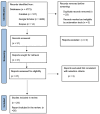Diagnosis, management and outcomes of incarceration or intussusception of Fallopian tubes following uterine perforation after vacuum aspiration or dilatation and curettage of the uterine cavity: a systematic review of the literature
- PMID: 40297933
- PMCID: PMC12042149
- DOI: 10.52054/FVVO.2024.12791
Diagnosis, management and outcomes of incarceration or intussusception of Fallopian tubes following uterine perforation after vacuum aspiration or dilatation and curettage of the uterine cavity: a systematic review of the literature
Abstract
Background: Dilation and curettage and vacuum aspiration are frequently performed gynaecological procedures used to treat uterine pathology. This procedure carries a risk of uterine perforation, which can lead to injury of abdominal organs and, rarely, to fallopian tubes.
Objectives: To evaluate symptoms and diagnostic signs and to propose the most appropriate management for the intussusception and incarceration of fallopian tubes following uterine aspiration and curettage.
Methods: We screened three major databases (Medline, Scopus, Google Scholar) from 2000 to May 2024. Our review examined tubal incarceration, causes, management, symptoms, parity, diagnosis timelines, visceral injury, and surgical complications. The methodological quality of the included studies was assessed using the JBI Critical Appraisal Checklist for case reports.
Main outcome measures: Diagnostic methods, complications and management of tubal incarceration following uterine perforation.
Results: We identified 24 papers, all of which were case reports or case series. In our analysis, tubal incarceration was observed in 25 of 26 cases (96.2%) and in 2 of which (7.7%) it was associated with the entrapment of the infundibulopelvic ligament. In 1 of 26 cases (3.8%) intussusception of the fallopian tube was observed. The most frequently manifested symptoms were abdominopelvic pain, vaginal bleeding, vaginal discharge and amenorrhoea. The mean time to diagnosis was 15.4 months, with transvaginal ultrasound being the primary diagnostic tool, followed by hysteroscopy and diagnostic laparoscopy.
Conclusions: Diagnosing this condition should involve a detailed medical history, a comprehensive clinical examination, and imaging evaluations. If instrumental investigations are negative but suspicion remains, hysteroscopy and/or laparoscopy may be necessary.
What is new?: Tubal incarceration complicating uterine perforation can be managed using hysteroscopy and laparoscopy.
Keywords: Fallopian tubes incarceration; aspiration; curettage; intussusception; systematic review; uterine perforation.
Copyright© 2025 The Author. Published by Galenos Publishing House on behalf of European Society for Gynaecological Endoscopy.
Conflict of interest statement
Conflict of Interest: No conflict of interest was declared by the authors.
Figures
Similar articles
-
Intussusception and incarceration of a fallopian tube: report of 2 atypical cases, with differential considerations, clinical evaluation, and current management strategies.J Minim Invasive Gynecol. 2011 Mar-Apr;18(2):246-9. doi: 10.1016/j.jmig.2010.10.009. J Minim Invasive Gynecol. 2011. PMID: 21354072
-
Laparoscopic Management of an Intrauterine Fallopian Tube Incarceration After Curettage for a Non-progressing Pregnancy.J Minim Invasive Gynecol. 2019 Jul-Aug;26(5):805. doi: 10.1016/j.jmig.2018.09.770. Epub 2018 Sep 19. J Minim Invasive Gynecol. 2019. PMID: 30243687
-
Interventions for non-tubal ectopic pregnancy.Cochrane Database Syst Rev. 2020 Jul 1;7(7):CD011174. doi: 10.1002/14651858.CD011174.pub2. Cochrane Database Syst Rev. 2020. PMID: 32609376 Free PMC article.
-
Intrauterine Fallopian Tube Incarceration after Suction Curettage with Uterine Perforation.J Minim Invasive Gynecol. 2022 Apr;29(4):457-459. doi: 10.1016/j.jmig.2021.12.006. Epub 2021 Dec 11. J Minim Invasive Gynecol. 2022. PMID: 34902595 No abstract available.
-
Hysteroscopic management of omentum incarceration secondary to uterine perforation: Case report and review of literature.J Obstet Gynaecol Res. 2020 Sep;46(9):1916-1920. doi: 10.1111/jog.14355. Epub 2020 Jun 17. J Obstet Gynaecol Res. 2020. PMID: 32558009 Review.
References
-
- American College of Obstetricians and Gynecologists' Committee on Practice Bulletins—Gynecology. ACOG Practice Bulletin No. 200: Early Pregnancy Loss. Obstet Gynecol. 2018;132(5):197–207. doi: 10.1097/AOG.0000000000002899. - DOI
LinkOut - more resources
Full Text Sources


